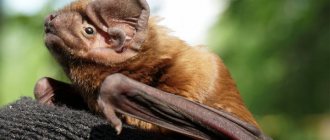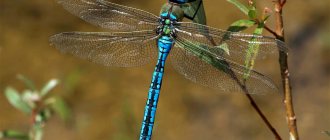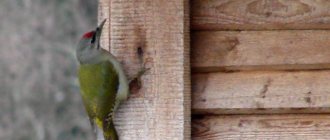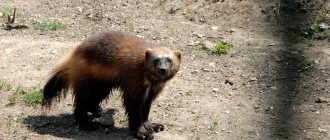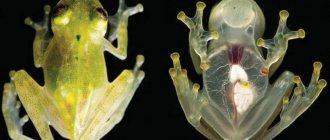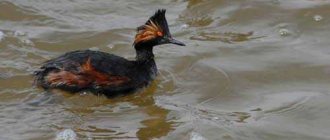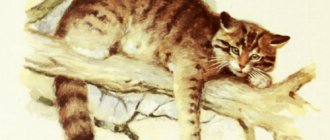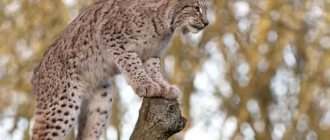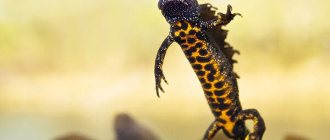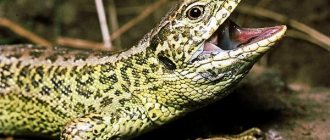10689
The pear peacock eye (Saturnia pyri) is listed in the Red Books of the Astrakhan Region, Belgorod Region, Voronezh Region, Karachay-Cherkess Republic, Penza Region, Republic of Dagestan, Republic of Ingushetia, Republic of Crimea, Rostov Region, Stavropol Territory and the Chechen Republic.
The Red Book contains all the necessary information about rare species of animals and measures for their protection. Detailed description and features of the species Peacock-eye pear »»
Astrakhan region
Status: I category. A species whose number of individuals has decreased to a critical level such that it may become extinct in the near future.
Spreading
Within the Astrakhan region - along the entire length of the Volga-Akhtuba floodplain to the city of Astrakhan.
Number
The number and trends in its changes are unknown.
Source: Red Book of the Astrakhan Region. Rare and endangered objects of flora and fauna. Ed. V.N. Pilipenko, M.V. Lozovskaya, V.I. Zakutnova, A.P. Laktionov, Yu.S. Chuikov, M.I. Pirogovsky (2014) Astrakhan: Astrakhan State University, Publishing House "Astrakhan University"
Nutrition and lifestyle
Butterflies are very thermophilic and live in the southern regions. They fly from April to June in the evening twilight and at night. Despite its size, the insect is very short-lived, its average lifespan is from 4-5 days to 2 weeks. During this time, butterflies do not feed at all; their main goal is procreation. Females are inactive, often sitting on branches and tree trunks waiting for males, emitting pheromones to attract them. Males, on the contrary, fly a lot in search of a partner. In the dark, they can even be mistaken for a small bird or bat. In the 19th century, entomologist Jean Henri Fabre found that a male Saturnia pear can detect a female more than 10 km away. The pear peacock eye is listed in the Red Book of individual states and regions as a rare species, the number of which is insignificant.
Belgorod region
Status: 0 category. Possibly an extinct species.
Spreading
In the Belgorod region, until the early 70s of the 20th century, it was not uncommon, sometimes developing on cultivated fruit trees.
Number
The latest finds date back to 1998. Such a rapid reduction in prevalence and abundance could lead to the complete extinction of the species throughout the region.
Source: Red Book of the Belgorod Region. Rare and endangered plants, fungi, lichens and animals. Ed. Prisny A.V. (2005) Belgorod: JSC "Belgorod Regional Printing House"
Life cycle
During her short life, the female lays from 250 to 400 white-gray eggs on thin branches or leaves of food trees. The caterpillars hatch in 10-20 days. After hatching, they actively eat the leaves of various fruit trees, reaching a length of 10 cm at the end of development. The formation of the larva lasts 1.5-2 months, and its color changes with each molt. Having reached the peak of its development, the caterpillar descends into the root part of the trees, makes a pear-shaped cocoon and turns into a pupa. She spends the winter in this form. With the onset of spring warmth, hatched butterflies leave their cocoons. In case of unfavorable conditions, the pupa can overwinter again. 1 generation develops per year.
Penza region
Status: I category. Endangered species.
Spreading
In the region, it is known to live in the Penza, Mokshansky, Maloserdobinsky, Zemetchinsky districts and the city of Penza, on the northeastern border of the range.
Number
Peacock eye caterpillars, due to their low numbers and rarity, do not cause significant harm to fruit trees.
Source: Red Book of the Penza Region. Animals. Ed. Ilyin V.Yu. (2005) Penza: OJSC IPK “Penzenskaya Pravda”
Peacock eyes and man
Since peacock eyes are not numerous and feed on low-value tree species, they do not cause harm to humans, and the Chinese oak peacock eye has been bred in China on special plantations for 250 years. These butterflies are used in the same way as the silkworm to obtain silk threads from cocoons. The threads of the peacock eye are coarser than those of the silkworm, so they are woven not with silk, but with comb. All species of these butterflies need protection as unique creations of nature.
Republic of Crimea
Status: I category. The species is endangered.
Spreading
From Crimea it is known from two finds from the outskirts of Simferopol (1970 and 1976). Biology in Crimea is unknown.
Number
The number and trends in its changes are unknown.
Source: Red Book of the Republic of Crimea. Animals. Rep. ed. S.P. Ivanov, A.V. Fateryga (2015) Ministry of Ecology and Natural Resources of the Republic of Crimea. IT ARIAL LLC, Simferopol
Interesting Facts
- The Saturnia pear moth scares away birds with the help of its coloring: when an enemy approaches, it opens its wings, and the bird, seeing eyes directed at it, gets scared.
- At the beginning of the 20th century, some sources noted Saturnia pear as a minor pest of fruit crops. But the number of the butterfly declined towards the end of the century, and now the pear peacock eye does not cause harm. Although its caterpillars feed on fruit trees, due to their small numbers they cannot significantly damage them. This species of butterfly has no economic importance, unlike some other species of peacock eyes, which are silkworms. But the large night peacock eye invariably pleases people with its beauty.
- The great nocturnal peacock's eye and the great diurnal peacock's eye butterflies are not related, as the former belongs to the peacock eye family and the latter to the nymphalidae family.
- In May 1889, the famous artist Vincent Willem van Gogh, seeing an unusual butterfly in the garden of the Saint-Rémy-de-Provence clinic, was struck by its beauty and immediately made a charcoal sketch, and then a painting emerged from the sketch. The painting depicts a pear peacock eye, although the artist himself mistakenly called it “Death's Head Hawkmoth.” The museum in which it is located has renamed the painting. Now it is called “Imperial moth” (“Peacock-eye”).
- The species is listed in the Red Book of Ukraine as a “rare species” whose numbers are insignificant; only in the south of the country in favorable years is it locally common.
Video
Rostov region
Status: II category. A species that is declining in numbers in the region.
Spreading
In the Rostov region. butterflies are regularly observed in the area. Rostov-on-Don, Aksay, Bataysk, Taganrog, Kamensk-Shakhtinsky, Shakhty, village. Sinyavskoye, hut. Nedvigovka, village Kagalnika, r. village Mountain and other places.
Number
On the Don it is still common, but not numerous, and the number is decreasing.
Source: Red Book of the Rostov Region. Volume 1. Animals. Ed. SOUTH. Arzanov, G.B. Bakhtadze, V.P. Belik et al. (2014) Rostov-on-Don, Ministry of Natural Resources of the Rostov Region
About the appearance of peacock eyes
A pair of Chinese oak peacock-eyes on a cocoon pupa.
Depending on the species, these insects can be either very small or simply “giant” in size. For example, the small peacock eye has a wingspan of no more than 8 centimeters.
Antennae of the peacock mimosa (Argema mimosae).
As for the large representatives of the family, which inhabit mainly tropical zones, their wings reach a span of even 27 centimeters! The average size of the wings of peacock eyes in the unfolded state ranges from 12 to 15 centimeters.
Selenium peacock eye (Astias selene).
In appearance, the body of the peacock eye resembles ordinary night moths: it is covered with villi that form a thick fluff. The wings have a fairly simple shape.
The Sikkimese Lepa (Loepa sikkima) is one of the few brightly colored peacock-eyes.
The color of peacock eyes is often modest, inconspicuous and even camouflage. Nature came up with this for a reason, because members of the family are nocturnal creatures. However, there are also species whose wings have bright shades or bright patterns.
Stavropol region
Status: II category. A species that is declining in numbers in the region.
Spreading
In the Stavropol region it was recorded in the Caucasian Mineral Waters area, on the Stavropol Upland and in the village. Cherished.
Number
In 1980, more than thirty males flew to one female in Pyatigorsk. From 1886 to 1990, single butterflies were observed in light traps in the vicinity of Stavropol and Pyatigorsk. In 1999, not a single male flew to the female. In recent years, he was registered in the village. Cherished.
Source: Red Book of the Stavropol Territory. Rare and endangered species of plants and animals. Animals. Ed. Chernogorov A.L., Garkusha V.F., Panasenko N.S., Shapovalov V.A. and others (2002) Stavropol: OJSC "Poligraphservis"
Description
The Great Nocturnal Peacock's Eye, or Pear-Eyed Peacock's Eye, is the largest butterfly in Europe. Its wingspan reaches 150 mm. Females are slightly larger than males. The insect's body is thick and densely pubescent. The wings are wide, pubescent at the base, brownish-gray in color, with prominent stripes and spots. In the middle of each wing are large dark spots outlined by a light and then black stripe, reminiscent of the “eye” on the peacock’s tail. Along the lateral edge of the wings there is a light cream edging, bordered by a wide dark stripe, interrupted at the apex.
Reproduction of pear peacock eye
Saturnia pears are nocturnal moths. They fly from April to June in the evening twilight and at night. Females are less mobile: they mainly sit on branches and tree trunks. Males are more active, fly a lot, and can fly even during the day. Thanks to their long, sensitive antennae, males sense the female's pheromones over vast distances. Back in the 19th century, French entomologist Jean Henri Fabre found that a male Saturnia pear detects a female 10 km away, but if he is deprived of his antennae, this ability disappears.
Male. Photo by: Josef Dvořák
Female. Photo by: Josef Dvořák
An adult pear peacock eye butterfly does not feed, and the lifespan of a large night peacock eye is from 4-5 days to 2 weeks. Males live about 8 days, females - up to 20 days. After mating, female Great Night Peacocks search for a suitable location to lay eggs. They lay 250-410 eggs in a single layer in several piles or rows on thin branches or leaves of trees, which are suitable for further feeding of the caterpillars. In 24 hours, a female can lay up to 140 eggs, although by the end of her life this number is reduced to 2-3 eggs. Having laid all the eggs, the butterfly dies. The Saturnia fruit egg is white-gray in color and measures 2x2.5 mm.
Photo by: Tony Pittaway
Saturnia pear caterpillars hatch in 10-20 days. After hatching, they eat part of the shell of the egg in which they were located, and then actively eat the leaves of fruit trees: not only pears, but also apple trees, sloe trees, cherries, cherry plums, plums, and walnuts. Also, pear peacock eye caterpillars feed on the leaves of cherry, apricot, peach, quince, almond, currant, grape, blackthorn, olive, ash, elm, elm, linden, birch, poplar, alder, maple, plane tree and other deciduous plants. When emerging from eggs, the caterpillars are about 5-6 mm in size, but after feeding, they become very large: 9-10 cm long and as thick as an adult’s finger. The development of the caterpillar lasts 1.5-2 months, and its color changes throughout its life:
- When hatching from an egg, the pear peacock eye caterpillar is black or dark brown in color. Four rows of warts, from which long hairs protrude, are colored light brown.
Photo by: Enrico Ferrari
- In the second stage of development, warts become orange.
Photo by: Lubomír Klátil
- At the third stage, the caterpillar's body acquires a green-blue tint, the warts become yellow, and the head and anal segments become brown.
Photo by: Lubomír Klátil
- During the fourth stage of development, as well as adult caterpillars, they have a yellowish-green color and sky-blue warts, on which, in addition to hairs, spines filled with liquid appear. In addition, a long yellow stripe becomes clearly visible on the side of the body.
Photo by: Lubomír Klátil
- Before pupation, the caterpillar of the pear saturnia acquires a golden-brown color, due to which the blue warts look even more vibrant.
Photo credit: Fabio scardino, CC BY-SA 4.0
By the way, adult pear peacock eye caterpillars can squeak. By rubbing their jaws, they make sounds that precede the release of a special secretion that scares away potential enemies: birds and bats.
Pear peacock eye caterpillars actively feed from May to August, and around July-August they leave the tree crown, slide down the trunk and begin to cocoon. With the help of salivary glands, the caterpillar secretes special silk threads and wraps itself in them. Typically, cocoons are located in the root part of fodder trees, as well as between stones. Some cocoons can also be found attached to tree branches. The pear peacock eye cocoon is very dense, pear-shaped, brown, 35-50 mm long. Already in the cocoon, the caterpillar turns into a pupa. She spends the winter in this form.
Photo credit: Bejolino, CC BY-SA 3.0
The great night peacock eye produces only one generation per year. If the weather is not favorable and the spring and summer are cold, the pupa can overwinter again: thus, the species maintains the population without exposing itself to danger during the breeding season. Reactivation of the pupa requires a period of 120-140 days with temperatures ranging from 8 to 16 degrees Celsius. If the spring is warm, butterflies leave their cocoons, rise to some height to spread and dry their wings, and take off.
Photo by: Josef Dvořák
Insect reproduction
Peacock-eyes breed very rarely . As a rule, such butterflies are able to reproduce only once in a year. At the beginning of the mating season, male butterflies begin to sense females through their sense of smell and their scent. Their proboscis is incredibly good at capturing the scent of a female; they can smell them 10 kilometers apart.
You can start breeding this type of butterfly if climatic conditions allow you to start breeding them. It is worth noting the fact that males die after mating with females. Place the butterfly in a room that is not cramped, where it will feel comfortable. Send a male to her, and after mating, after a certain period of time, the male will die, and the female will lay eggs.
After laying the eggs of the large nocturnal peacock eye, it is recommended to move them into a separate container and put them in a dark room. After about 9–10 days, caterpillar larvae will begin to emerge from the eggs. In order for them to grow and develop, they need the right diet. Since the great night peacock loves to live on fruit trees, foliage from these trees is needed for food.
The caterpillars are very good at eating foliage and developing. As soon as they get a little bigger and you notice that their appetite is much larger than before, you can safely plant them on trees in the garden. Place them on cherry leaves or on a pear tree, they love this kind of foliage.
When the time comes for the caterpillars to pupate , stock up on large plastic containers, preferably transparent ones, this will make it more convenient to observe the development of the cocoon. Place a branch from the fruit tree on which the caterpillar is located in the containers.
After the cocoon has acquired a fairly solid shape, it can be removed from the branch and placed in an ordinary box. It only takes 14 days for caterpillars to transform into butterflies. As soon as you see butterflies starting to emerge from their cocoons, place tree branches next to them. This is required so that after birth they can sit on them and dry their newly spread wings. With this simple method you can breed these beautiful night beauties in captivity. They reproduce in much the same way in their natural habitat, only without human intervention, many of the eggs laid die.
Where does the great night peacock butterfly live?
The pear peacock eye is a heat-loving, frost-intolerant, exclusively southern species of butterfly. The range of this species covers southern and partly central Europe, the Mediterranean from the Iberian to the Balkan Peninsula, the Czech Republic, Slovakia, southern Romania, Ukraine, and the southern European regions of Russia. Also, the large night peacock eye lives in North-West Africa (Algeria, Morocco), Turkey, the Middle East, the Caucasus, Transcaucasia, and inhabits countries such as Georgia, Armenia, Azerbaijan, Iran, Israel, Syria, Lebanon.
The Saturnia pear butterfly lives in gardens, parks, on the edges of deciduous forests, in open forests, and on bush-covered slopes. Occasionally, individual individuals are found in more northern regions, but since these butterflies are not prone to migration, this can most likely be explained by the fact that their pupae, caterpillars or laid eggs came north along with fruits sent for sale from the southern regions. But these cases are isolated and not typical. Perhaps, with the onset of global warming, the great nocturnal peacock will expand its territory of residence.
Photo credit: Avereanu, CC BY-SA 3.0
The meaning of the pear peacock butterfly
At the beginning of the 20th century, some sources noted Saturnia pear as a minor pest of fruit crops. But the number of the butterfly declined towards the end of the century, and now the pear peacock eye does not cause harm. Although its caterpillars feed on fruit trees, due to their small numbers they cannot significantly damage them. This species of butterfly has no economic importance, unlike some other species of peacock eyes, which are silkworms. But the large night peacock eye invariably pleases people with its beauty.
Photo credit: Andrew Butko, CC BY-SA 3.0
